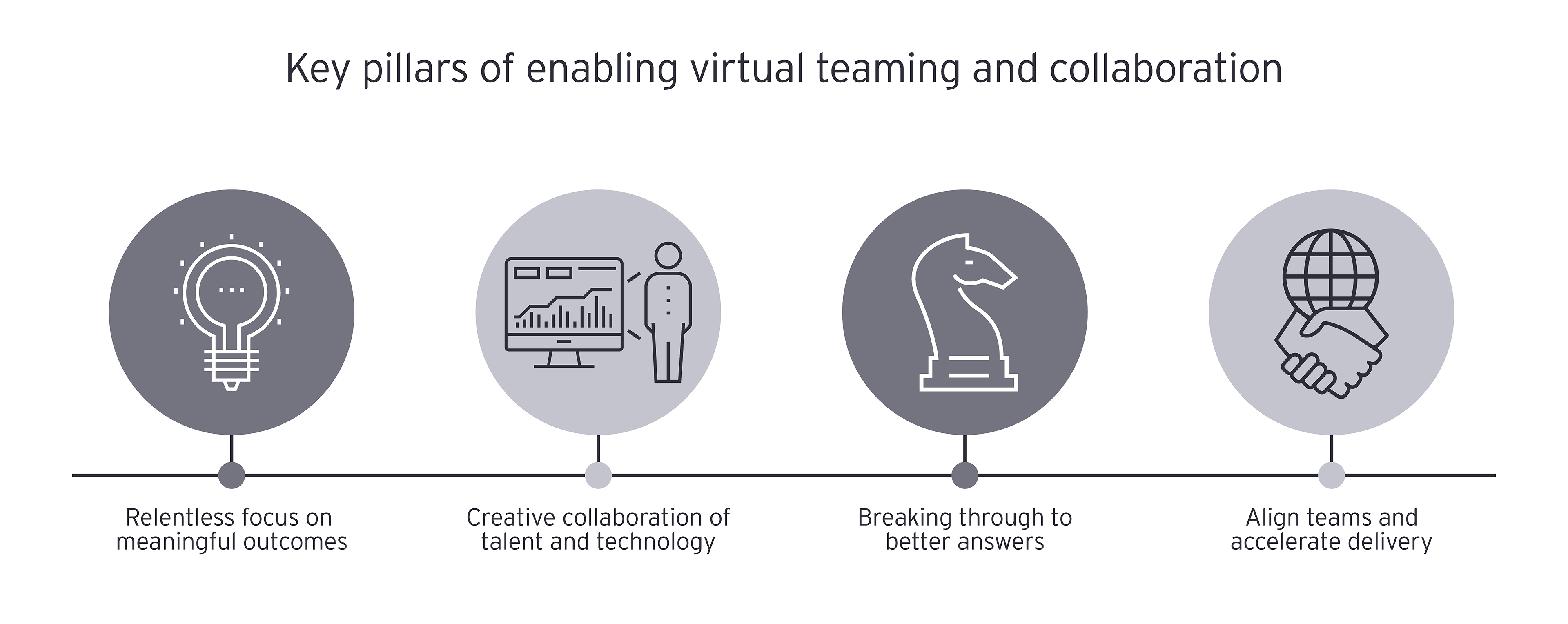Pre-pandemic, most organizations had a digital agenda with varying degrees of urgency and commitment. Many of these plans have now been newly prioritized. But as we adjust to our new normal, organizations need to split their efforts between recovery and readiness for what’s to come.
Those who are managing this crisis well have taken targeted actions to sustain business operations by stabilizing core systems and critical infrastructure while enhancing workforce solutions to restore employee productivity. As we shift our focus back to the future, organizations need to accelerate digital transformation efforts to enhance virtual teaming and collaboration, rethink customer engagement, and modernize technology capabilities.

Chapter 1
Reinforcing leadership alignment
Culture and talent might drive modern delivery, but it is leadership that is the starting point.
Modern delivery is a product-centric technology model addressing the response to customer and organizational problems or opportunities with speed, quality and focus. This model blends product management, scaled Agile, DevSecOps, and Agile architecture to help clients focus on customer value and responding to change.
There are two key drivers for modern delivery: culture and talent. Both are driven by an organization’s leadership, specifically how leadership teams are aligned throughout the organization. Changing the way business operates on a granular level requires companies to align leadership across the board in a value-first mindset that creates a sense of urgency and momentum in delivering sustainable results – virtually.
Evolutionary leadership
To effectively drive transformation, leaders must create conviction in the workforce to reaffirm a vision. Developing a transformation narrative based on vision and value statements helps create a connection to the desired end-goal and bring about shifts in mindset and culture. Focusing on value-led outcomes instead of tactical activities is more easily comprehensible and builds corporate stamina to manage change.
Engaged workforce
When IT and business align to connect business and technology experiences, cross-functional teams of engaged workers share accountability for driving results. While the pandemic school of hard knocks has limited spontaneity in interactions, it is important to reduce presumptions and biases so employees can stretch themselves toward achieving a shared vision. To flip the script on failing transformations, organizations need to be guided by strategic themes and make organizational decisions that align with the strategy and vision to achieve those goals. This will enable a product and platform delivery organized around Agile product teams that innovate, experiment and launch products in record time, with quality and security.

Chapter 2
Rethink customer engagement
There has never been a more critical time for customer centricity.
The pandemic has accelerated the evolution of the global consumer. Accelerating digital transformation requires leaders to reassess their product roadmap and any underlying assumptions about consumer behavior. To succeed through the current crisis and build future capabilities, consumer-facing organizations need to anticipate emerging consumer trends. That means reimagining how we respond to the challenges customers face, prioritizing investments in customer experience, and stress testing customer journeys to rapidly adapt and respond to new demands.
1. Customer focus
The future customer will have ever shifting expectations. Adapt too slowly, and you risk irrelevance. Get it right, and you can make bold progress. You should develop an ecosystem of insight and action. By using foundational technology elements like chatbots, predictive analytics, process automation, and cross-channel fluidity, you can turn customer service into a strategic asset that focuses on precise customer engagement strategies and personalization.
2. Customer experience
Experience leaders are constantly setting new benchmarks for customer experience. Through hyper-personalization, smart connected products can decrease fulfilment times and leapfrog innovation. So organizations now have an opportunity to accelerate digital-first or digital-only customer journeys and lean into higher margin experiences that offer more data to drive optimization of outcomes.
3. Smart feedback loops
The COVID-19 pandemic has created a crisis event that will either make or break the exchange of value between company and customer. By deepening customer insights, organizations can create better products, services, and experiences, resulting in greater loyalty, retention and growth. Organizations also need to change the way they prioritize CX investments. The crisis has accelerated the automation and virtualization of customer-facing operations and the need to continuously learn from these interactions.

Chapter 3
Enhance virtual teaming and collaboration
The adjustment to a virtual work environment needs continuous collaboration.
“Individuals and interactions over processes and tools”1 is a core value enshrined in the Agile manifesto. However, a virtual work environment presents unique challenges for Agile development for teams who traditionally rely on in-person interactions. Cross-functional teams now need to leverage connected experiences using digital collaboration tools and shared accountability for driving results. With distributed Agile teams, key events such as performance improvement planning need to be conducted virtually.

Tools should work for people; people should not work for tools. That’s why true digital transformation is less about technology and more about interactions. As organizations pivot to using a modern suite of technology for virtual collaboration, it is equally important to engineer the interactions to replicate “real world” scenarios. In this rapidly changing environment, organizations must think differently, gather diverse points of view, and continuously collaborate with teams across regions. Business-as-usual answers are likely to fall short. The challenges we face now require new thinking, fast action, rapid course correction, and continuous feedback. How do we maximize the productive and problem-solving teaming capabilities amid the challenges that we face?
1. Enable micro-interactions
This can be achieved through a wide variety of tool sets like group chats for valuable unstructured conversations, and polling for confidence votes. Outside of formal meetings, it is powerful to create informal and persistent small group check-ins for free-flowing topical discussions that facilitate knowledge sharing and keep remote culture strong.
2. Virtual teaming requires more than virtual meetings
Upfront planning is required, such as, putting in additional time for meeting pre-work and coaching to help team members get over technology hurdles and enable seamless interactions. For example, in the context of planning sessions, the team needs to put a great deal of effort into updating and cleaning the backlog prior to the meeting so that features are more granular and well understood before the team presents to the larger audience. Facilitators should also spend more time coaching teams who are not very experienced in Agile ways of working.
3. Rethink virtual meetings
Rely on seasoned facilitators with extensive experience to conduct these sessions. If multiple teams are involved, additional facilitators can check-in with each team and make sure they are engaged in real time. Limit “zoom fatigue” by allocating shorter times to sessions (e.g., multiple partial days instead of full day sessions) to accommodate remote logistical challenges and encourage engagement.

Chapter 4
Modernize technology capabilities
A previously unthinkable speed to market is achievable if the right tech capabilities are in place.
Modern delivery means getting your solutions ready and out into the world at a speed and scale that was previously unobtainable. But evolving technology capabilities are keeping pace with new demands.
1. On-demand services
New cloud and infrastructure technology provides the architectural runway needed to support a rapidly evolving product roadmap.
2. Trust by design
The public’s fear, uncertainty, and curiosity about the pandemic creates a fertile environment for cyber threat actors to adapt their vectors, tactics, and targeting strategies. Multifaceted risk mitigations (e.g., role-based access and multifactor authentication) can help combat these threats.
3. Automation at scale
Accelerating the delivery, deployment, and monitoring of new customer experiences requires adoption of a DevOps culture, practices and automation across the enterprise. An “automation first” foundation and mindset is fundamental to scaling in modern delivery, allowing teams to build, deploy, and operate efficiently and effectively.
If history is any guide, we know that periods of sudden disruption and rapid change tend to shift the table on pre-established plans. For all the players, these moments can either be a threat or an opportunity.
Craig Crawford, Executive Director, Technology Consulting, Ernst & Young LLP, Barry A Smith, Principal, Technology Consulting, Ernst & Young LLP, Shalini, Manager, Technology Consulting, Ernst & Young LLP and David K Huntington, Manager, Business Consulting, Ernst & Young LLP, also contributed to this article.
Summary
Business leaders who are managing the crisis created by the pandemic have targeted their focus on keeping core systems stabilized and critical support infrastructures up and running. They have also identified solutions to help the workforce sustain productivity. As we move toward the new normal, business leaders must now drive and accelerate their digital transformation plans with a view to enhancing virtual ways of working, retaining and inspiring customers, while also modernizing the organization's tech capabilities.

